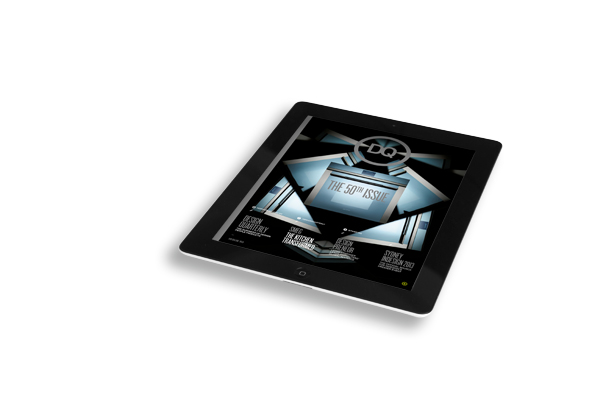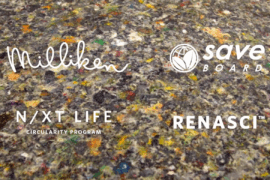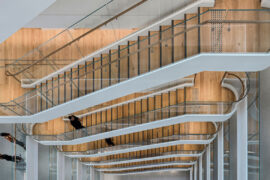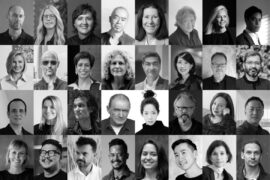Siriyot Chaiamnuay and Arisara Chaktranon, the founders and Design Directors of Thai studio Onion, craft spaces that have the power to affect deeply.
I remember us making the decision when we were having drinks. We ended up designing the first project together in that pub [laughs]. But that’s the thing. I think we both have ideas that tend to go in the same direction. We used to lay down six colours for selection, and 90 per cent of the colours we chose matched.”
Siriyot Chaiamnuay recalls the beginning of his career with Arisara Chaktranon. After graduating from the architecture course at Chulalongkorn University, he went to London where he completed his master’s degree at the Architectural Association. He was hired by Zaha Hadid Architects and worked there for a period of time.

A mirrored wall within the restaurant at Sala Rattanakosin reflects the Temple of Dawn across the Chao Phraya River. Photo by Wison Tungthunya.
Arisara Chaktranon, also an alumnus of Chulalongkorn University’s Department of Architecture, completed her master’s degree in interdisciplinary design (interior, industrial and identity) at the Design Academy Eindhoven, before returning to Bangkok where she spent four years working in architecture firms. The two joined forces and opened Onion, their Bangkok-based architecture and design studio, in 2007.
Amidst the growing number of architecture studios in Thailand, Onion’s idiosyncratic architectural language is undeniable – particularly the seamless blend between the interior and exterior elements of architecture. Simplistic yet full of details, their design resonates with the studio’s name. After all, the smooth surface of an onion hides many superimposed layers.

The lobby at Sala Samui Chaweng Beach Resort, which overlooks the pool and the beach beyond. Photo by Wworkspace.
“That’s our character,” says Chaktranon. “When we were coming up with the name of the studio, neither of us wanted to use our own names, so we were looking for an object that everyone’s familiar with. Onion was our choice because it’s this simple cooking ingredient found in every home around the world. It’s something that people can easily remember.”
One of Onion’s earlier projects, Sala Rattanakosin (a renovation project completed in 2013), is a boutique hotel located in old town Bangkok. Despite its rather small scale, the design holds many details that are indicative of Onion’s architectural character. “If we were to sum up what we did with the project, it would be the clash between the old and the new,” says Chaiamnuay. The partners made what was already old, older. This can be seen in the stripping of the wall surfaces to reveal bricks, and the creation of a material clash with aluminium (much of which was custom cast).

A balcony pool suite at Sala Samui Chaweng Beach Resort, designed by Onion. Photo by Wworkspace.
Onion maximised access to the view of the central prang (spire) of Wat Arun Ratchawararam Ratchawaramahawihan (Temple of Dawn) situated across the river. Borrowed views of the ancient structure are incorporated into the space through a witty use of mirror. “Even from the restrooms, you can see the view of the prang. Everything around the site is used to its fullest potential,” says Chaiamnuay. “It’s like an onion in a kitchen. It depends on where the kitchen is. The method we employ with each project is different.”
What if the kitchen is situated in a space where there’s no surrounding urban context whatsoever? “There’s always the sky,” says Chaiamnuay. Sala Samui Chaweng Beach provides an example of what he means. This hotel was launched in 2018 with the second phase of construction only recently completed. Onion used the moon as the key motif of the architecture and interior design, from the hierarchal access route from the beach to the massive circular outdoor pool (the full moon) to the forms of the buildings and the details in the rooms.

Brick walls with multiple curvatures frame the sky at Sala Ayutthaya. The shadows change constantly throughout the day. Photo by Wison Tungthunya.
The level of privacy increases as one progresses through the property, mimicking the gradual shift from the full moon to the new moon. The arches in the facade are reminiscent of the half-moon shape while the roof over the single corridor renders visual effects of reflected light and shadow on different planes. The white building therefore appears as if it was ‘shaded’ by natural light, similar to the moon whose form appears to change according to its position relative to the sun and Earth.
The use of architectural form to create effects of light and shadow on architectural surfaces can also be seen in Sala Ayutthaya in Bangkok (completed in 2014). “In that project we used local materials such as bricks, which were constructed into an arced wall. It creates this effect of curved shadow lines and triangular corners – these speak of the Thai aesthetic,” explains Chaktranon.
During our discussion of Thai-ness in architecture, Onion shares some insightful opinions. “If we think of our stand in this world, it (the Thai-ness) is a characteristic that makes us distinctive, but it works well only when there’s the past we can refer to,” offers Chaiamnuay. Chaktranon adds: “But this Thai-ness can’t stay still forever. The society changes, people change, and this Thai-ness changes accordingly. We see something, we use it, but we have to apply it in such a way that it can respond to society so you’re able to move forward.”

Siriyot Chaiamnuay and Arisara Chaktranon in the Onion studio. Their work spans from hospitality and commercial projects to residential, art installations and products. Photo by Adit Sombunsa.
INDESIGN is on instagram
Follow @indesignlive
A searchable and comprehensive guide for specifying leading products and their suppliers
Keep up to date with the latest and greatest from our industry BFF's!

A curated exhibition in Frederiksstaden captures the spirit of Australian design

For Aidan Mawhinney, the secret ingredient to Living Edge’s success “comes down to people, product and place.” As the brand celebrates a significant 25-year milestone, it’s that commitment to authentic, sustainable design – and the people behind it all – that continues to anchor its legacy.

After speaking to our readers, architects, designers and specifiers, we isolated a demand for greater efficiency in information retrieval. Our answer: BINDER.
The internet never sleeps! Here's the stuff you might have missed

Developed by Milliken in partnership with saveBOARD, Renasci™ is a breakthrough circular flooring product made from carpet and soft plastics waste – designed to be repeatedly recycled.

Brad Krauskopf, CEO & Founder of Hub Australia, tells us about Hassell’s design for Hub Australia Martin Place.

With the 2025 INDE.Awards now over, it’s time to take a breath before it all begins again in early December. However, integral to the awards this year and every year is the jury – and what an amazing group came together in 2025.